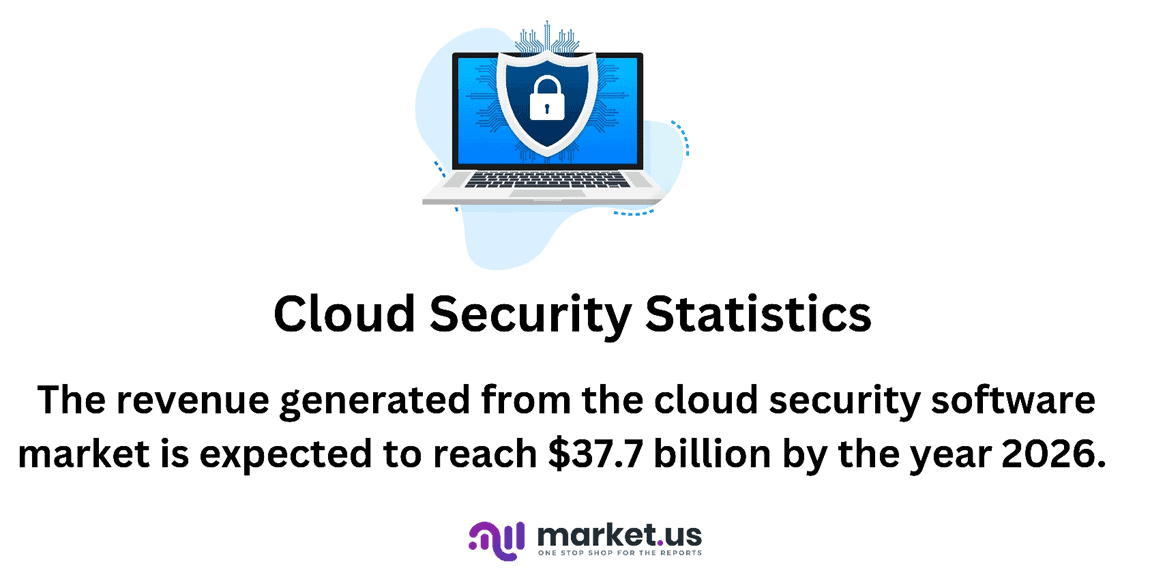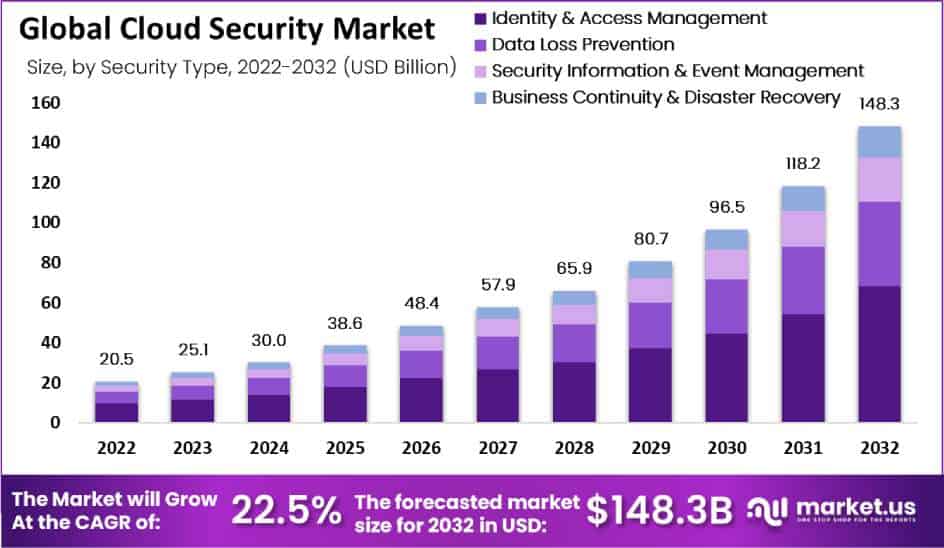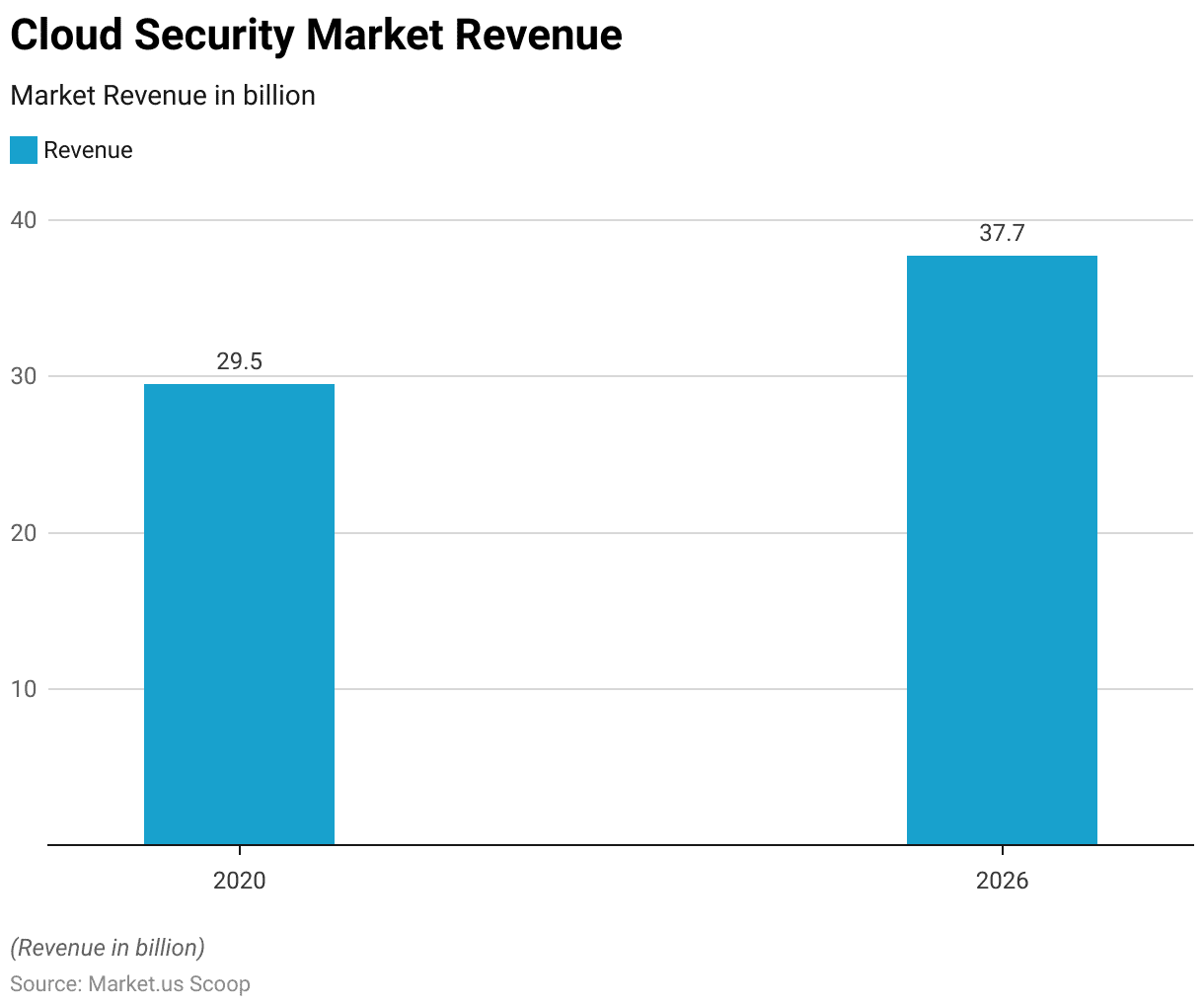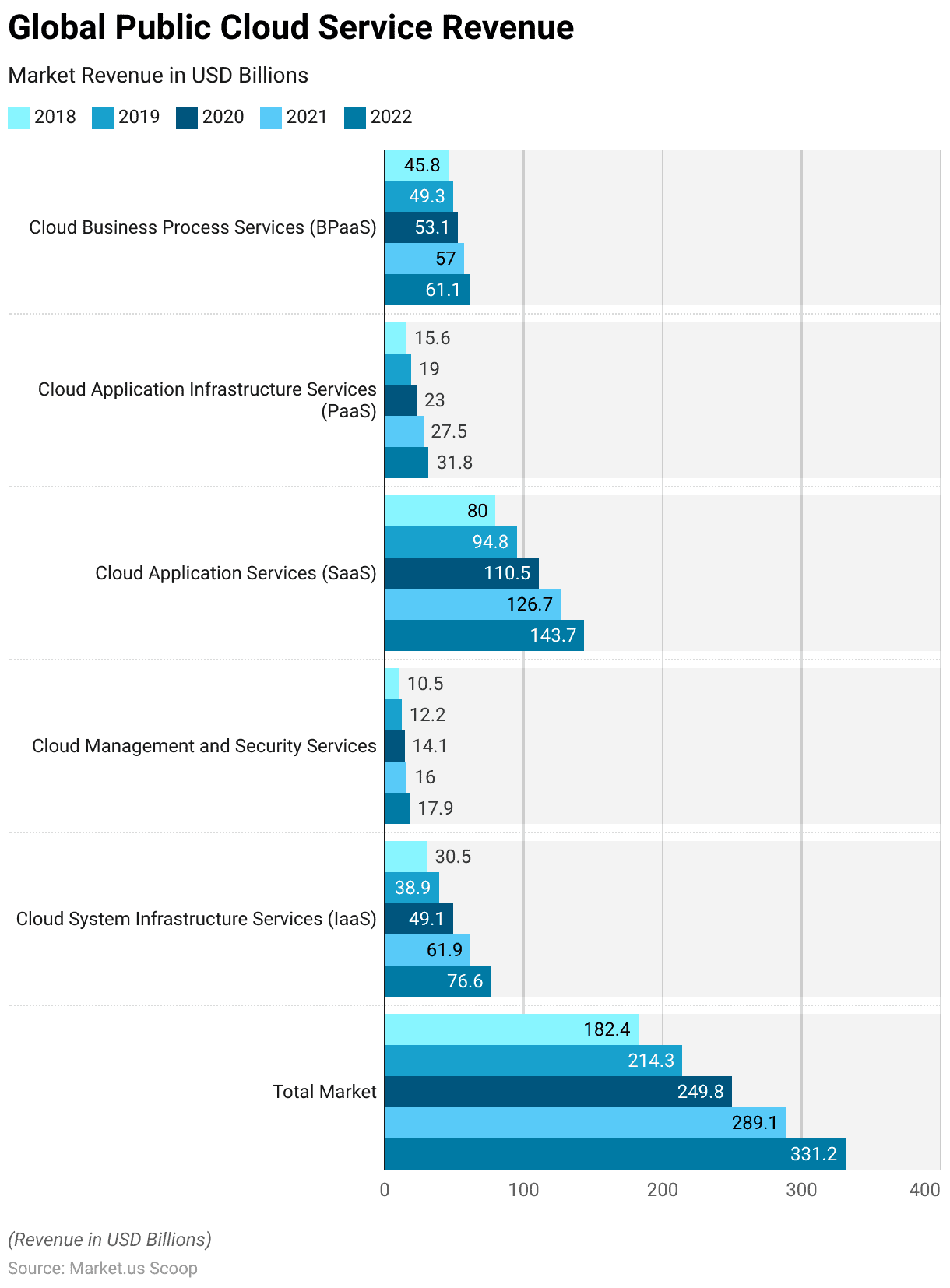Table of Contents
- Introduction
- Editor’s Choice
- Global Cloud Security Software Market Size
- Data Storage in Cloud
- Types of Public Cloud Services (IaaS, PaaS, SaaS)
- Global Public Cloud Service Revenue
- Encrypting Data in the Cloud
- Cloud Security Statistics by Challenges
- Spending by Cloud Security Statistics
- Cloud Security Statistics by Upcoming Trends
- Recent Developments
- Conclusion
- FAQ’s
Introduction
Cloud Security Statistics: Cloud security is a critical concern for organizations as they increasingly rely on cloud computing services.
Ensuring the protection of data and resources in the cloud environment is paramount to prevent unauthorized access, data breaches, and potential financial and reputational damage.
While the cloud offers benefits like scalability and cost-effectiveness, it also presents challenges. Organizations often grapple with issues such as data privacy, as they entrust cloud providers with sensitive information.
Moreover, a shortage of cloud security expertise can hinder the effective implementation of security measures.
Balancing the advantages of the cloud with these security challenges is a complex task that requires diligent planning and robust strategies to safeguard digital assets in the cloud.

Editor’s Choice
- The revenue generated from the cloud security software market is expected to reach $37.7 billion by the year 2026.
- End-users will spend more money on public cloud services in 2023 than they did in 2022. With a projected total of $590.8 billion. That’s a 20.7% increase compared to 2022’s figure of $489.3 billion.
- The majority of organizations (69%) acknowledged having experienced data breaches or exposures as a result of multi-cloud security settings.
- The majority of organizations (82%) identify cloud cost management as their primary security concern, while 79% view security as their primary concern.
- The average cost associated with a data breach is estimated to be $4.35 million.
- The majority of data breaches (82%) involved human factors, including social attacks, errors, and exploitation.
- The global market for public cloud services is expected to grow at a CAGR of 17% in 2022-2022. While the total IP traffic of global cloud data centers is expected to be around 10.6 ZB/yr. in 2022-2023.
- 54% of all Chief Information Officers (CIOs) will adopt cloud software within the next three years.
- 80% of enterprises have experienced an increase in the number of cloud-based attacks. Of these, approximately 33% are attributed to cloud-based data breaches.
- 27% are environment intrusion attacks; 23% are crypto mining attacks; and 15% are failed audits.

Global Cloud Security Software Market Size
- The revenue generated from the cloud security software market exhibited a steady growth trajectory over the years, with a recorded figure of $29.5 billion in 2020.
- This upward trend is expected to continue, as projections indicate a substantial increase, reaching $37.7 billion by the year 2026.
- Moreover, this growth can be attributed to the escalating adoption of cloud computing solutions across industries. Which has consequently elevated concerns regarding data protection and security.
- As organizations increasingly rely on cloud-based infrastructure and services. The demand for robust cloud security software continues to surge, driving the expansion of this pivotal market segment.

Data Storage in Cloud
- In 2022, the three leading public cloud providers (AWS, Microsoft Azure, and GCP) accounted for 62% of total cloud computing market share. AWS accounted for 33%, Microsoft Azure accounted for 21%, and GCP accounted for 8%.
- More than 90% of businesses already have part of their IT infrastructure in the cloud
- In 2015, 30% of corporate data was hosted in the cloud. By 2022, that percentage had risen to 60%. The report goes on to explain how the cloud has rapidly replaced legacy data warehousing systems. The cloud computing market is expected to reach USD 1.5 trillion by 2030.
- The majority of enterprises (48%) have opted to utilize the cloud for the storage of classified data, both encrypted and non-encrypted.
- Google Drive is the most widely utilized cloud storage service in the world, with a usage rate of 94.4%.
(Source – Cloud wards)
Types of Public Cloud Services (IaaS, PaaS, SaaS)
Software as a Service (SaaS) – Cloud Security Statistics
- By 2020, the global SaaS market is expected to be worth $157 billion. Which is more than double what it was in 2014.
- In 2020, the number of cloud-based software-as-a-service (SaaS) workloads will reach 206 million, up from 206 million in 2018, as last updated.
- The global market for public cloud services is expected to grow at a CAGR of 17% in 2022-2022. While the total IP traffic of global cloud data centers is expected to be around 10.6 ZB/yr. in 2022-2023.
- The global Software-as-a-Service (SaaS) market is expected to grow at a CAGR of 9% between 2019 and 2023, reaching a total of $60.36 billion.
- End-users will spend more money on public cloud services in 2023 than they did in 2022. With a projected total of $590.8 billion. That’s a 20.7% increase compared to 2022’s figure of $489.3 billion.
- It’s estimated that by 2021, the global corporate mobile software-as-a-service (SaaS) market is expected to amount to 7.4 billion dollars.
- Approximately 38% of Software-as-a-Service (SaaS) applications, as well as cloud-based email services, are subject to cyber-attacks.
(Source – St Strategy Analytics)
Platform as a Service (PaaS) – Cloud Security Statistics
- The public cloud is expected to grow at a 12% compound annual growth rate (CAGR) and reach a total of USD 331 billion by 2022.
- It looks like the market for Platform-as-a-Service (PaaS) is going to keep growing – it’s predicted that it’ll be worth $28.4 billion by 2023. With a compound annual growth rate (CAGR) of 24.7% between 2019 and 2023.
- 90% of businesses that buy public cloud infrastructure as a service (IaaS) and PaaS will use an integrated.
- The PaaS market is expected to grow to USD 216 billion by 2022.
Infrastructure as a Service (IaaS) – Cloud Security Statistics
- 83% of all enterprise workloads will be in the cloud by 2020.
- On-premises workloads are projected to decrease from 37% in 2020 to 27% in 2023.
- The cloud service market is expected to grow to a whopping $163 billion by 2021. Covering everything from storage to hosting and computing.
- By the end of 2019, IaaS is forecast to grow by 27.6%.
(Source – Forbes)
Global Public Cloud Service Revenue
- The global public cloud service market has seen substantial growth between 2018 and 2022.
- In 2018, it showed promise with Cloud Business Process Services (BPaaS) contributing $45.8 billion. Cloud Application Infrastructure Services (PaaS) at $15.6 billion. Cloud Application Services (SaaS) reaching $80.0 billion. Cloud Management and Security Services totaling $10.5 billion, and Cloud System Infrastructure Services (IaaS) accounting for $30.5 billion, resulting in a total revenue of $182.4 billion.
- This growth continued in the following years, with each category’s revenue consistently increasing.
- By 2022, Cloud Business Process Services had risen to $61.1 billion, Cloud Application Infrastructure Services to $31.8 billion, Cloud Application Services to $143.7 billion, Cloud Management and Security Services to $17.9 billion, and Cloud System Infrastructure Services to $76.6 billion.
- Consequently, the total market revenue for 2022 reached an impressive $331.2 billion, highlighting the significant role of public cloud services in modern business operations and their continued expansion in the digital landscape.

Encrypting Data in the Cloud
- Less than one-third of organizations (21%) have encrypted more than 60% of their data in a cloud environment.
- Most ransomware cases that are successful in encrypting the data involve the data being stored in the cloud, with 59% of cases.
- In the cloud, the majority of companies (46%) rely on infrastructure and architecture to encrypt data, while 38% rely on compliance regulations.
- A total of 55% of organizations employ more than five encryption key management solutions, while only 12% employ one or two.
(Source: Forbes)
Cloud Security Statistics by Challenges
- The majority of the surveyed enterprises (75%) identified cloud security as their primary priority.
- The majority of respondents (33%) have a high level of concern regarding cloud security, with 42% having a very high level of concern and 25% having a moderately high level of concern.
- 68% of responding cyber security professionals classify cloud infrastructure misconfiguration as an urgent issue
- 58% of respondents identify unauthorized access as a major issue and cause for concern.
- Insecure APIs are identified by 52% of respondents as a major cloud security issue.
- Securing cloud assets and resources presents a significant challenge for 31% of large enterprises.
- For 30% of businesses, cloud security is a major issue due to a lack of knowledge and skills.
- For 28% of SMBs migrating assets and workloads to the cloud securely is the biggest challenge.
(Source: Forbes)
Multi-cloud security challenges
- Multi-cloud usage: 81% of organizations have already implemented multi-cloud technology
- Maintaining security in the multi-cloud: 70% of companies don’t trust their ability to keep security up-to-date in both their on-site and cloud environments, even though they use lots of different security tools to protect their cloud apps.
- Data breach in the multi-cloud: 69% of organizations reported data breaches or exposures as a result of multi-cloud security.
- Biggest security obstacle with the multi-cloud: In 2022, the main impediment to cloud security was a lack of knowledge in deploying and administering a comprehensive solution for all cloud environments.
- A significant 37% of respondents from all over the world indicated that their organization was having difficulty managing the speed of transformation when it comes to protecting its multi-cloud environments.
(Source -Radware)
Cloud Security Data Breaches
- 88% of cloud data breaches are caused by human error.
- In the past year, the majority of enterprises (79%) have experienced at least one data breach related to the cloud.
- Over the same period, 43% of businesses have reported more than ten breaches
- In a hybrid cloud environment, the average cost for a breach was $3.61 million.
- The cost of a data breach for public clouds is 28.3% higher than for hybrid clouds.
- Privileged accounts are responsible for a whopping 34% of identity-related attacks over the past two years.
- About 90% of cloud users aren’t taking advantage of the full range of permissions they’ve been given – they’re only using 5% of them.
- Most companies don’t even bother with multi-factor authentication to make sure their privileged accounts are secure, with only 38% using it.
- 32% of businesses said they had problems with unauthorized users having access to sensitive information.
- The majority of organizations (69%) acknowledged having experienced data breaches or exposures as a result of multi-cloud security settings.
- The average cost associated with a data breach is estimated to be $4.35 million.
- The majority of data breaches (82%) involved human factors, including social attacks, errors, and exploitation.
Spending by Cloud Security Statistics
- Cloud security spending around the world has been skyrocketing in recent years. In 2020, it was only 595 million US dollars, but by 2021 it had skyrocketed to over 4 billion US dollars.
- By 2023, it’s predicted that cloud security spending will be even higher at over 6 billion US dollars.
- Security services providers will make up more than 40% of the total security spending in 2023. The research firm predicts that security services will take in $76.5B in 2023.
- By 2025, more than 70% of all new remote access systems will be using zero-trust networks instead of VPNs. That’s a huge jump from 2021 when only 10% of remote access systems were using zero-trust networks.
- Organizations are projected to invest an estimated USD 6.69 billion in cloud security expenditures in the year 2023, representing a year-on-year increase of nearly 27%.
Cloud Security Statistics by Upcoming Trends
- Concerning upcoming trends, as we progress through 2021 and employees either return to office settings or adopt hybrid remote work arrangements, the momentum behind digital transformation and the adoption of cloud technology is set to continue its upward trajectory.
- Organizations that have not yet embraced this shift will likely feel compelled to do so to remain competitive.
- Consequently, global end-user expenditure on public cloud services is forecasted to reach almost $600 billion this year, marking a notable increase of over 20% compared to the $490.3 billion spent in 2022.
- Regarding enterprises, their spending on cloud services is projected to surge by 29% over the next year. This upward trend is expected to result in an increase in cloud computing budgets across the board.
(Source: Gartner, Flexera)
Recent Developments
Acquisitions and Mergers:
- Palo Alto Networks acquires Bridgecrew: In early 2023, Palo Alto Networks completed its $156 million acquisition of Bridgecrew, a cloud security company specializing in infrastructure-as-code security. This acquisition aims to enhance Palo Alto Networks’ Prisma Cloud security platform by integrating Bridgecrew’s automation and security tools.
- CrowdStrike acquires Humio: CrowdStrike acquired Humio, a log management and observability technology provider, for $400 million in late 2023. This merger is expected to strengthen CrowdStrike’s cloud security capabilities by providing real-time insights and advanced threat detection.
New Product Launches:
- Microsoft Defender for Cloud: In mid-2023, Microsoft launched Defender for Cloud, a comprehensive security solution designed to protect multi-cloud and hybrid environments. This new product includes advanced threat protection, security posture management, and compliance reporting.
- Google Cloud’s Assured Workloads: Google introduced Assured Workloads for Europe in early 2024, an extension of its cloud security offerings that ensures data residency, compliance, and sovereignty requirements for European customers.
Funding:
- Lacework raises $525 million: In 2023, Lacework, a cloud security platform, secured $525 million in a Series D funding round to expand its security offerings and enhance its machine learning capabilities for threat detection and compliance.
- Orca Security secures $340 million: Orca Security raised $340 million in early 2024 to accelerate the development of its cloud-native security platform and expand its global footprint, aiming to provide comprehensive security visibility and protection.
Technological Advancements:
- AI and Machine Learning Integration: Cloud security providers are increasingly integrating AI and machine learning to enhance threat detection, automate security processes, and provide predictive analytics, improving the overall security posture of cloud environments.
- Zero Trust Architecture: Advances in Zero Trust security models are being adopted to ensure that no user or device is inherently trusted, requiring continuous verification of identity and access permissions to protect cloud resources.
Market Dynamics:
- Growth in Cloud Security Market: The global cloud security market is projected to grow at a CAGR of 13.6% from 2023 to 2028, driven by the increasing adoption of cloud services, rising cyber threats, and the need for regulatory compliance.
- Increased Adoption in Healthcare: Cloud security solutions are seeing significant adoption in the healthcare sector to protect sensitive patient data, ensure compliance with regulations like HIPAA, and support telehealth services.
Regulatory and Strategic Developments:
- EU’s General Data Protection Regulation (GDPR): Compliance with GDPR continues to drive investments in cloud security, ensuring that organizations handle personal data securely and transparently while meeting stringent data protection requirements.
- US Executive Order on Improving the Nation’s Cybersecurity: In early 2024, the US government issued an executive order to enhance national cybersecurity, emphasizing the importance of securing cloud services and adopting modern security practices like multi-factor authentication and encryption.
Research and Development:
- Quantum-Resistant Encryption: R&D efforts are focusing on developing quantum-resistant encryption algorithms to future-proof cloud security against potential threats from quantum computing, ensuring long-term data protection.
- Cloud Security Posture Management (CSPM): Researchers are advancing CSPM solutions to provide continuous monitoring, automated remediation, and comprehensive visibility into cloud environments, helping organizations maintain strong security postures.
Conclusion
Cloud Security Statistics – Cloud security is a key part of the contemporary digital landscape. While cloud adoption continues its meteoric rise, the prevalence of security challenges, evident in the increasing number of breaches, underscores the criticality of robust cloud security strategies.
However, the data reveals persistent concerns around data privacy, skill shortages, and the imperative to secure cloud assets effectively.
Looking ahead, emerging trends like Zero Trust Architecture and AI-driven security are poised to reshape the cloud security paradigm.
These statistics collectively emphasize that cloud security is no longer an option but an absolute necessity in preserving the integrity and trustworthiness of cloud environments as businesses navigate the complex terrain of digital transformation.
FAQ’s
Cloud security encompasses the measures and practices put in place to protect data, applications, and infrastructure in cloud computing environments. It aims to ensure the confidentiality, integrity, and availability of resources in the cloud.
Cloud security is crucial because it helps safeguard sensitive information and applications stored in the cloud from cyber threats, data breaches, and unauthorized access. It is essential for maintaining trust, complying with regulations, and ensuring business continuity.
Cloud security follows the shared responsibility model. Cloud providers, such as AWS, Azure, and Google Cloud, are responsible for securing the physical infrastructure (data centers), while customers are responsible for securing their data, applications, and configurations within the cloud.
Common cloud security threats include data breaches, misconfigured cloud settings, insider threats, Distributed Denial of Service (DDoS) attacks, and malware targeting cloud environments. These threats can compromise data confidentiality and disrupt services.
Organizations can protect data in the cloud by using encryption, access controls, and robust identity and access management (IAM) policies. Regular data backups and monitoring for suspicious activities are also crucial security measures.
Discuss your needs with our analyst
Please share your requirements with more details so our analyst can check if they can solve your problem(s)



